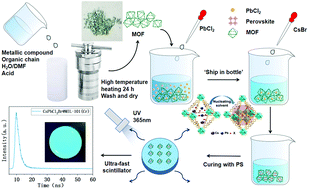Confinement of all-inorganic perovskite quantum dots assembled in metal–organic frameworks for ultrafast scintillator application†
Abstract
Nucleation and growth of quantum dots (QDs) are thermodynamic processes driven by the total Gibbs free energy change (ΔG). We discuss the nucleation and growth theory of perovskite quantum dots (PeQDs) inside a metal–organic framework (MOF) as a strong constraint framework, which can effectively confine the size of QDs below 3 nm and achieve a scintillator with an ultra-fast transient lifetime of fluorescence. Therefore, based on the requirements for the optical properties of ultra-fast scintillation materials, two kinds of suitable MOFs (UiO-67-bpy and MIL-101(Cr)) were selected for synthesis. The method of ‘ship-in-bottle’ was adopted to embed perovskite quantum dots CsPbBrCl2 into MOF cages to form PeQDs@MOF composite materials, which is different from the one-pot method. In order to further improve the stability of PeQDs@MOF, polystyrene was used to cure the composite scintillator, which can resist exposure to UV light and withstand the ISO level 4 test, with the fastest transient lifetime of 2.13 ns and a fluorescence emission wavelength of 445 nm.



 Please wait while we load your content...
Please wait while we load your content...